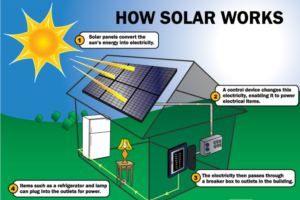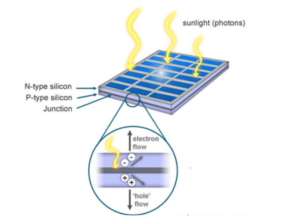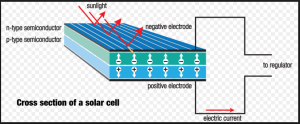How do Photovoltaic cells work to generate electricity?
We all know that Solar panels are made up of many Photovoltaic cells. But have you ever wondered how do photovoltaic cells work to generate electricity from sunlight? Here in this post, I am going to explain how solar panels work step by step to generate electricity.
If you’re considering solar panel installation for your home, you may be curious to know how solar panels actually produce electricity. So keep reading to learn how solar panels harness energy from the sun and convert it into usable electricity.
But before I show how does solar energy work step by step, let me first describe what is a solar panel.
What is a solar panel?
Solar panels are made up of many Photovoltaic or solar cells. Just like the cells in a battery, the solar cells in a solar panel are small devices designed to generate electricity. However, while a battery’s cells make electricity from chemicals, a solar panel’s cells work through a phenomenon called the photoelectric effect to produce electricity from sunlight. Now, let’s see how do solar cells work.
How do photovoltaic cells work?
The photoelectric effect is the ability of matter to emit electrons when a light is shone on it. It is a property exhibited by some special materials when exposed to light that causes them to absorb the tiny particles or packets of energy called photons, with which the light is composed of. These photons knock electrons free from the atoms in the special materials of the solar cells resulting in the flow of electricity.
Now, how do photovoltaic cells work or how do solar cells work? Photovoltaic or Solar cells are made of special materials called semiconductors. Silicon is the most commonly used semiconductor for making a solar cell. Silicon carries millions of tiny atoms that have charged electrons. The most common design of solar panels today uses two different types of silicon – positively charged (P-type) and negatively charged (N-type). This is to create a solar cell made up of two different layers, a layer of positively charged silicon and a layer of negatively charged silicon sandwiched together. To achieve this, small quantities of other elements are squeezed into the silicon layers.
The silicon in the top layer is combined with phosphorus atoms which contain more electrons to create a negatively charged silicon (N-type) layer and the bottom layer gets a dose of boron, which contains fewer electrons to create a positively charged silicon (P-type) layer. When these two different layers of opposite charges are separated and placed side by side inside a Solar cell or Photovoltaic cell it creates an electric field across the cell just like in a battery. This unique configuration enables a reaction that produces electricity when the silicon cells are exposed to sunlight.
How do solar panels generate electricity?
Now that it is explained how do Photovoltaic cells work let’s now see how do solar panels generate electricity using Photovoltaic cells.
Each Photovoltaic or solar cell generates very little power (a few watts) and so they are grouped together as modules. In order to maximize output dozens of the solar cells are packaged together into solar modules, which in turn are packaged into solar panels that are mounted on a rooftop and arranged to maximize their hours of exposure to direct sunlight.
In simple terms, a Photovoltaic (PV) solar panel converts the sun’s rays into electricity by using the photons or particles of light from the sun to knock electrons free from the silicon atoms in the solar cells resulting in usable electricity. This electricity can then be used to supply renewable energy to homes or businesses.
Sunlight is composed of minuscule particles called photons or “packets” of energy, which radiate from the sun in the form of electromagnetic radiation. As these light particles hit the solar cell, the energy from the photons is transferred to the loose electrons in the silicon atoms. The energized electrons are then able to escape their bond with the atoms and move freely from one layer to the other layer of the cell providing a flow of electricity. Because of the way, the cells are made with layers of material with different atomic structures, it creates an electrical imbalance within the cell, which acts a bit like a slope down which forces the free electrons to move in one direction creating a direct current, or DC. If conductors are attached to the positive and negative sides of a cell, it forms an electrical circuit and when the electrons flow through such a circuit in one direction, they generate Direct Current electricity or DC. This DC current is then sent to an inverter which converts the direct current into Alternating Current (AC) for use in businesses and homes.
How solar panels work step by step
Here’s a quick sum-up of how do solar panels work step by step to generate electricity for residential and business uses:
Step 1. The particles of sunlight (photons) hit the solar cells of the solar panel;
Step 2. The energy from the photons is transferred to the loose electrons in the atoms of the semiconductor material with which the solar cells are made of;
Step 3. The energized electrons escape their bond with the atoms and the free electrons move in one direction from one layer to the other oppositely charged layer of the solar cell thereby generating DC current;
Step 4. The DC current is then passed through an inverter which converts the Direct Current into Alternating Current (AC) for use in homes and businesses;
Step 5. Any excess electricity that’s not used is fed back into the grid;
Step 6. Whenever more power is needed than the solar system can produce or when the solar system is not generating power in real time the required power is drawn from the grid;
Step 7. An export/import meter monitors the energy exported compared to the energy imported from the grid;
You may also like to read: Off Grid Power System Using Solar – all you need to Know about
Frequently asked questions
Now that I have explained how solar panels work step by step, let me also answer some of the related questions often asked by potential solar panel users.
How much energy does a solar panel produce?
It would be evident from the explanation of how do solar panels work step by step to generate electricity, that the amount of energy a solar panel produces is not only proportional to the sun’s intensity but also depends on three factors – efficiency of solar cells, size of solar panel and the amount of sunlight directly hitting the panel.
A typical solar panel produces around 265 watts of power. This can vary based on the size and efficiency of the solar panel. The maximum power rating of each solar panel i.e. how much energy a solar panel produces during peak conditions is normally listed at its back. A peak Sun-condition is approximately equal to the power of the sun at noon on a clear day at the equator.
Most solar panels in the market today usually produce between 250 and 400 Watts of power. The output of solar panels mainly depends on factors like shading, orientation, and sun hours.
What are the advantages of a grid-tied solar system?
A grid-tied solar system provides many benefits. It provides backup power when the sun isn’t shining or if extra power is needed.
The electricity generated by the rooftop solar panels first supplies the needs of the home, with the grid supplying additional electricity as needed. When homes or businesses generate more electricity from their solar systems than their own requirements, the excess power is automatically exported to the public grid, and credit is allowed for this contributed electricity.
At night when the solar system is not generating power in real-time, the grid will provide energy for lights and other appliances as usual, in exchange for the excess energy it shared with the grid during the day. For this, an export/import meter is installed by the power company to monitor how much is being imported or exported during the day.
One of the biggest benefits that a grid-tied solar system provides to the grid is that it often produces electricity when and where the power demand is at its peak and most valuable. For example, in many regions demand for electricity peaks in the afternoon on hot, sunny days, when the use of air conditioning is high, and when the rooftop solar system is performing powerfully.
Grid-tied solar system, therefore, helps utilities meet peak demand without firing up the expensive and more polluting power plants. Rooftop systems also reduce the strain on the power transmission and distribution equipment as homes and businesses first draw power from their own system instead of relying completely on the electricity grid.
You may also like to read: Grid tied solar system explained – why it is better for home electricity
How many solar panels are needed to run a house?
The numbers of solar panels needed to run a house depend on location and roof size. The average homeowner will need about 30 solar panels to cover 100% of their energy usage.
Do solar panels work in winter?
Although solar panels do work in winter for obvious reasons, the energy output of the panels is comparatively lower than during the summer season because the days are shorter in winter. Moreover, during winter snow can temporarily reduce or completely shut down the output. Nevertheless, solar panels are actually more efficient in colder weather.
Do solar panels work at night?
Technically, Solar panels cannot produce energy at night as the photovoltaic cells in solar panels need sunlight to generate electricity. Nevertheless, your solar energy system would continue to provide electricity when the sun isn’t shining through backup power from the grid and solar battery storage.
You may also like to read: Is Solar renewable or nonrenewable?
Conclusion
On going through the post showing how solar panels work step by step to generate electricity you might think why solar panels aren’t the primary source of power in the world when sunlight is an abundant source of energy. The main reason for this is, the process of producing solar energy is still not a very efficient process. If you go through how do solar panels generate electricity it would be evident that for capturing direct sunlight the angle of the solar panels is very important for the efficiency of panels.
How much energy does a solar panel produce is measured by the sun-rays from the direct perpendicular sun. It would be apparent from how do photovoltaic cells work that if the solar panels are not facing the sun just right, the efficiency can drop considerably thereby reducing the amount of energy produced by the photovoltaic cells. This is why the amount of electricity created by solar panels is relatively low compared to the size of the panels packaged with solar modules.
However, with technological advances and improving efficiency, the production volume is steadily increasing resulting in a reduction in the capital costs of solar panels.
In any event, solar energy is gradually becoming a viable alternative in many situations. According to a recent report, more American homes than ever are investing in solar panels. The United States now has more than 77 Gigawatts (GW) of solar photovoltaic (PV) capacity installed, which is enough to power more than one in every 10 homes in America. In fact, a report from the International Energy Agency indicates that solar energy could become the largest global source of electricity by 2050. In short, with solar technology improving every day and costs dropping rapidly solar energy is truly the wave of the future.
You may also like to read: Solar Residential System Planning – an easy guide




Chase
Sep 29. 2016
Hi radharenu ganguly, this was a great in depth article. The science behind it is really amazing! I made a solar savings calculator on my website if anyone needs it. Thanks!
SolarEze
Oct 15. 2020
If one wants to do a roof solar panel, it should be thoroughly researched and studied. It is not just an easy diy project but you should dedicate time in understanding the pros and cons. Anyways, a great article you shared for us to get important insights.
radharenu ganguly
Oct 15. 2020
Hi,
Thanks for stopping by and your comments
Solar Medix
Sep 08. 2021
Hello, thanks for sharing this blog. this is very helpfull for me. if you want any help regarding solar company in nj then contact with Solar Medix.
Solar EnergieTechnik Ltd
Oct 06. 2021
Thanks for sharing the information about HOW DO SOLAR LIGHTS WORK. You have shared almost all The things about that. I loved the points you have mention. We wrote some points about Home Solar Lighting System To get info you can visit us https://infinitisolar.in/product/infiniti-solar-home-lighting-systems-20w-40w/
khizar habib
Oct 21. 2021
hi
thanx, forgive us nice information about how to install a solar panels. But I want to know now in particle video if you provide.
Solar in Massachusetts
Jan 12. 2022
How many solar panels needed in a house is a very helpful part in this Content.
Thank you Radharenu
Solar Medix
Nov 01. 2021
Hello, thanks for sharing this blog. this is very helpfull for me . if you want any help regarding solar maintenance then contact with Solar Medix. more detail click- https://solarmedix.com/
Mehedi@ eShikhon
Jan 23. 2022
Nice article
Bella @ Younus
Feb 05. 2022
Informative article about Solar panel.
radharenu ganguly
Feb 06. 2022
Hi Bella,
Thanks for your comment
Victoria Addington
Mar 11. 2022
It made sense when you clarified that solar panels do work in winter but with lower energy output. My sister told me that their solar system doesn’t work even in summer. I think they need solar system repair since solar panels are expected to work best during summer.
Tina
Apr 13. 2022
I appreciate the time and effort you put into your website and Informative article about How To Solar Panel Work.
radharenu ganguly
Apr 14. 2022
Hi Tina,
Thanks for your comments. I am glad that you liked the article
met solar
Apr 14. 2022
Nice article
Rebecca
Jun 01. 2022
thank you
Maxima Sale
Feb 17. 2023
Thank you for sharing. Very Informative article I bookmarked your blog. Hope to read more of your amazing articles